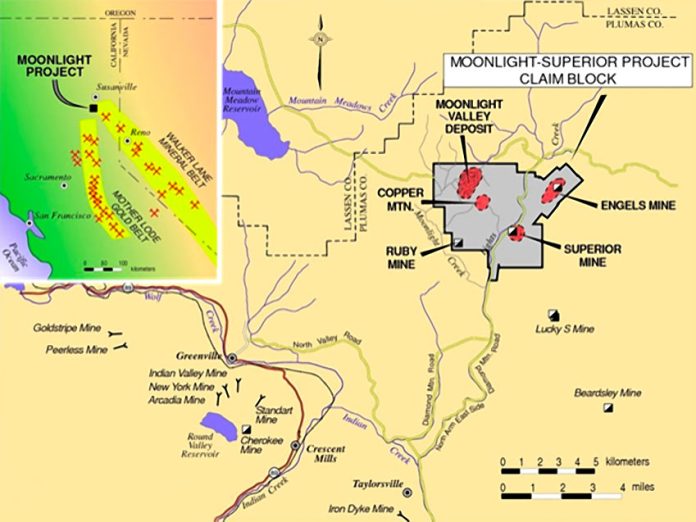In 2023, Canadian junior company US Copper Corp asked the Plumas County Zoning Administration for a determination of vested rights to mine the historic Engels and Superior mines in Indian Valley. Since the first contentious public hearing on the matter in October, the application — and the prospect of reopening the mines in general — have been a subject of discussion and debate in the community.
On Feb. 6, the county hired mining legal consultants Best Best & Krieger to review the record. BBK submitted a memorandum April 15 summarizing the results of its investigation. The firm found insufficient evidence to support a determination of a vested right to mine the sites. The memo and exhibits — a total of 520 pages — are available on the Plumas County Zoning Administrator’s landing page, along with the other records from the case.
A final decision on the determination of vested rights is expected at the May 8 zoning administration meeting. Representatives from US Copper and BBK are expected to attend. Public commenting will remain open up to and during the May 8 meeting.
The BBK memo includes a background and summary of the project before addressing applicable laws and analysis of the historical evidence, and reaching its conclusion.
Legal requirements for vested rights
“Vesting” exempts existing businesses from new and more restrictive zoning ordinances. This allows for the continuation of “nonconforming” land use, modernization of operations, and even increased production. However, the BBK memo explains, vested rights are limited to the area which the operator either actively used, or exhibited an intent to expand, at the time the relevant zoning ordinance was passed.
A party who desires to continue and expand excavation operations on property following a restrictive change in zoning of the property must meet a three-pronged test.
Specifically, the party must prove the following:
- The excavation activities were actively being pursued when the law became effective.
- The area the party desires to excavate was clearly intended to be excavated, as measured by objective manifestations and not by subjective intent.
- The continued operations do not, and/or will not, have a substantially different and adverse impact on the neighborhood.
Additionally, the vested right nonconforming use must not have been intentionally abandoned through “an overt act or failure to act.”
BBK’s findings in the case of Engels and Superior
BBK found insufficient evidence to support a determination of a vested right to mine the sites in the historical record provided by US Copper. Their 28-page memo includes the following points:
The background report does not contain enough information to substantiate vesting as of 1958.
The US Copper filing identifies July 8, 1958, when Plumas County adopted its first zoning ordinance, as the date for vesting. BBK found that “the Applicant has not provided sufficient information to make any determination on the type of physical operations that were occurring on the property just prior to the Vesting Date.”
Engels and Superior were indisputably active mines from the 1880s through the late 1930s. The US Copper background report describes multiple attempts to resume operations in the years that followed, but important documentation is missing from the chain of title history, according to the BBK memo. From 1951 through the 1958 vesting date it’s unclear whether mining activity took place at the site.
“This does not mean that no mining activities were occurring during this period. Rather, … the Background Report does not allow for any informed conclusion on the actual activities, mining or otherwise, occurring at the Mines or the surrounding property just prior to and at the Vesting Date.”
There is evidence the mine was abandoned under common law before the vesting date.
BBK also found “substantial evidence to support a conclusion that mining activities were common law abandoned” in the 1930s. The memo suggests the sale and dismantling of mining equipment and town infrastructure by 1938, and the sale of the railroad spur that served the site, including rails, tracks and cars, by 1939 demonstrates intent to abandon. The US Copper background report also “evidences a clear corporate decision to abandon operations at the Mines in the 1932 corporate records.”
“Vested rights cannot rely on the prior operations post abandonment regardless of future intentions, actions, or agreements,” the BBK report states.
Hypothetically, if rights were vested in 1958, there is evidence that they have since been abandoned.
Although vested rights exempt mining operations from local ordinances, they are still subject to some aspects of the state’s Surface Mining and Reclamation Act. Abandonment under SMARA is fundamentally different from abandonment under common law. Under SMARA, mines were required to submit a reclamation plan in 1988. SMARA also requires an “interim management plan” for any idle period longer than a year. Without an approved interim management plan, under the law mines “shall be considered abandoned and the operator shall commence and complete reclamation in accordance with the approved reclamation plan.”
The memo cites additional evidence of abandonment in the form of periods of inactivity, and a conversion of land use from mining to timber: “The conversion of the property from the mining industry to the lumber industry without filing the SMARA required interim management plan evidences an intent to abandon any mining operations on the property.”
Public comment open until May 8
Public comment on the proposed mine has been largely unfavorable. Eighty-eight public comments have been received. According to BBK’s analysis, five (5.7%) expressed support, nine (10.2%) raised procedural or social concerns, and the remaining 74 (84.1%) expressed opposition.
Plumas County Planning Director Tracey Ferguson is accepting public comment on the proposed mine until May 8, when the zoning administrator will make a final determination. She declined to elaborate on the BBK memo, referring those with questions at the April 16 Plumas County Board of Supervisors meeting to the BBK memo and the rest of the public record, available at the Plumas County Zoning Administrator website.
A hard copy of the memorandum, with or without exhibits, is available from the Planning Department at 555 Main St., Quincy, CA 95971, by calling 530-283-6214 or by emailing Ferguson at traceyferguson@countyofplumas.com. The planning department will charge 10 cents per page pursuant to the department’s fee schedule.






